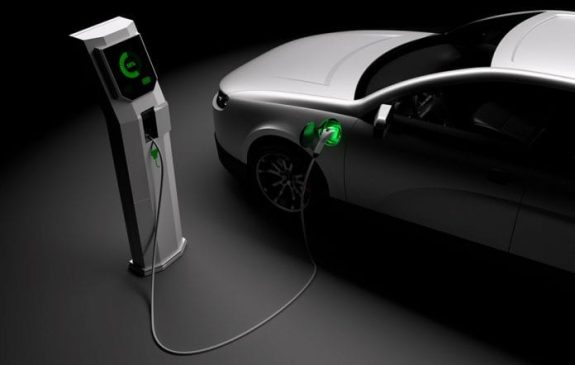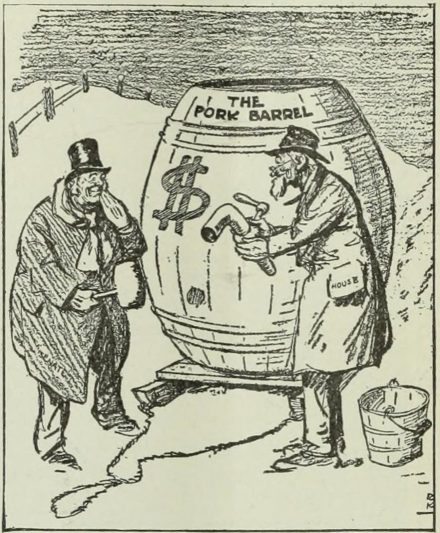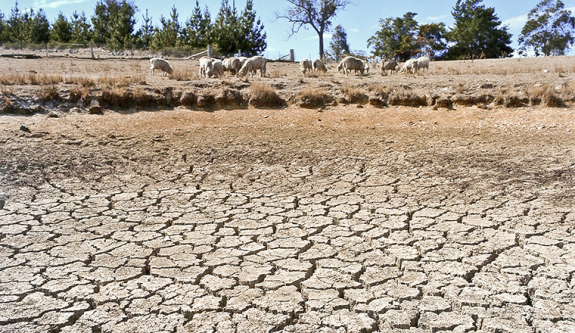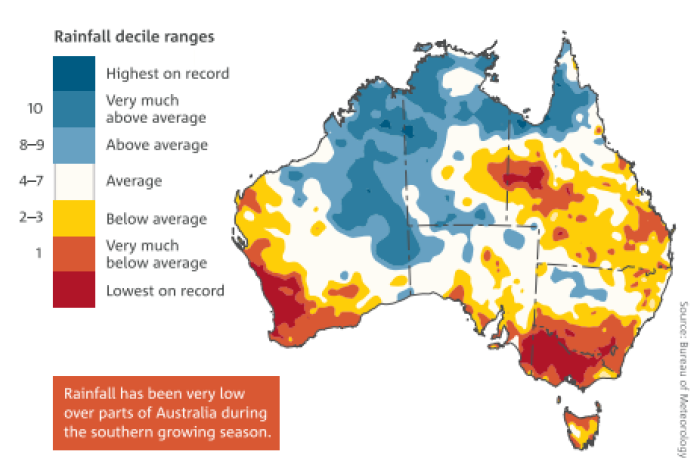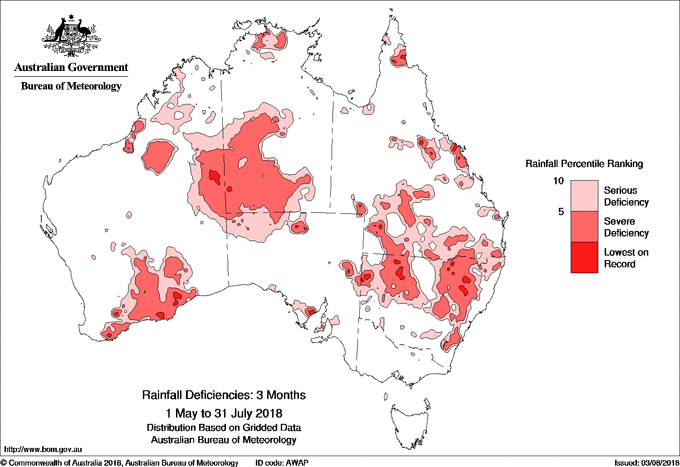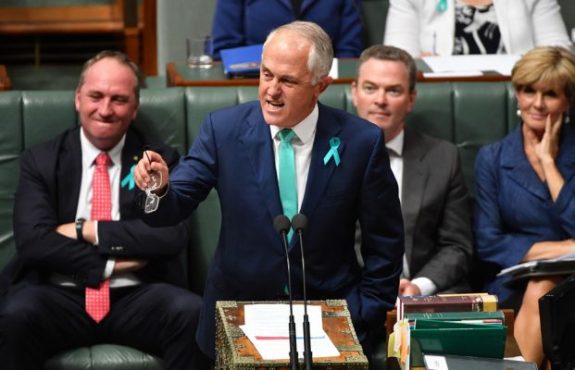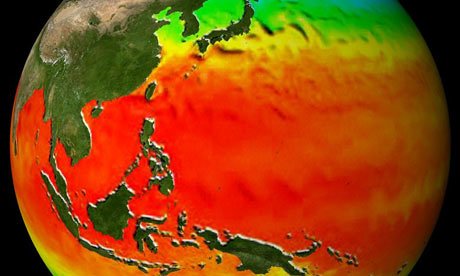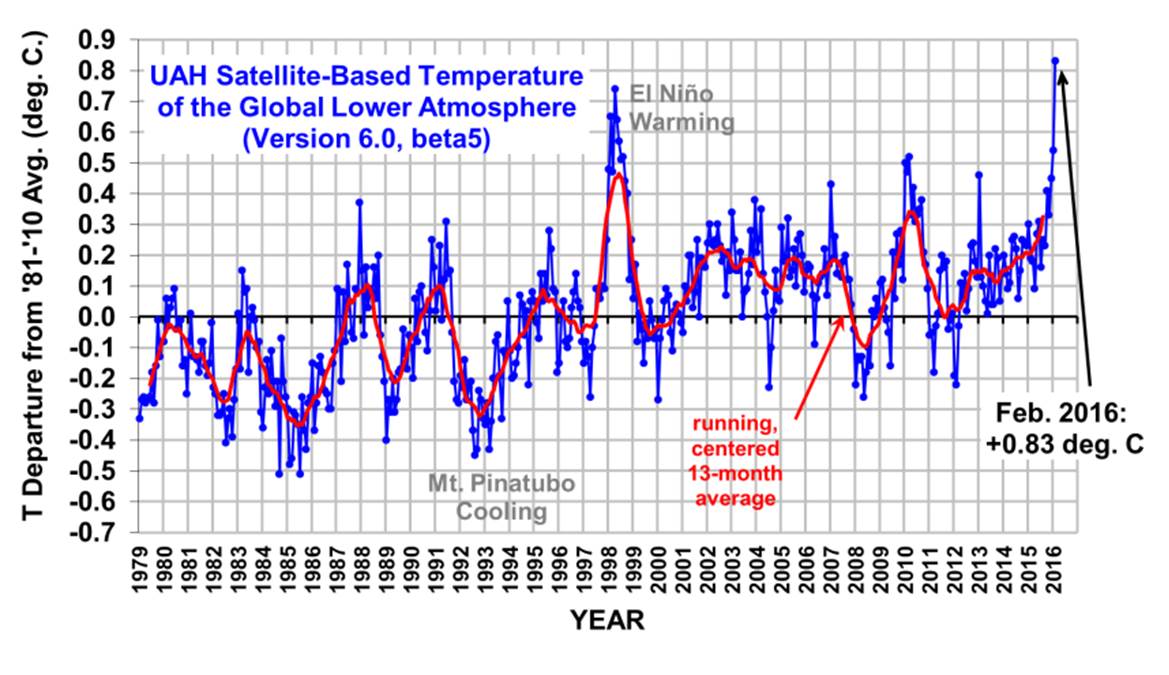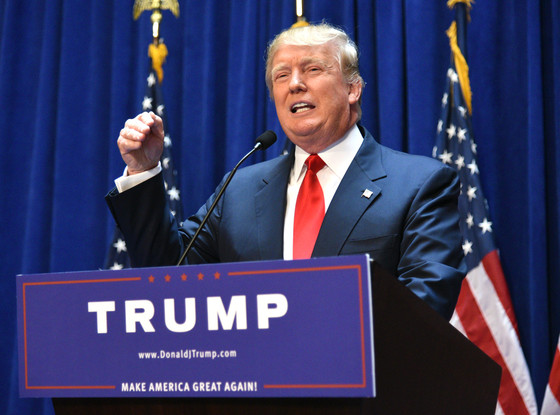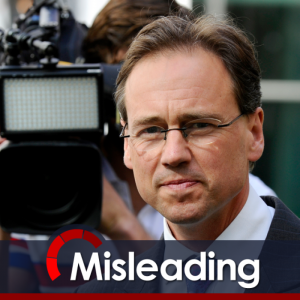Over the past eight years, Australians have joined the rest of the world in being entertained and amused by the absurdities of American politics. Some amongst us thought Sarah Palin represented the nadir of democratic politicians worldwide, and the pinnacle of politics as satire.
We were so wrong. It appears that politics can become far more absurd than the gun-totin’ moose-slaying soccer mom. First we had the rise, froth and tumultuous fall of Tony Abbott. And now we have Donald Trump. For months we have watched in horrified fascination as The Donald utters a never-ending stream of non-sequiturs and racist jibes and calls them politics. We watch and wait for the inevitable fall and await the rise of a more reasonable contender – a presidential candidate capable, perhaps, of being Presidential. And still we wait, while Donald Trump rides high through every poll and, after a few shaky first steps, each Republican primary.
In short, it now seems relatively likely that Donald Trump will be the Republican party’s contender for the US election at the end of this year. How could it have come to this? And, more importantly, what does the rise of Donald Trump mean for America, for the world, and for Australia? It’s worth thinking about these matters now as Trump’s unstoppable momentum becomes clearer.
Donald Trump, POTUS
From the very beginning, Trump has been written off consistently by most political pundits and media outlets. Like us, the electoral sages wait for the awakening, the moment when the public wises up to the character of the man. Calculations are made about Trump’s lack of support from his own party, about the consistent polls which have his “would never vote for him” rating higher than any other politician in history, and about the likelihood of a collapse in Trump’s support once he loses a Primary or two.
Despite these predictions and analyses, Trump is still on course to securing the nomination. Every primary sees his lead bolstered. According to Trump’s own rhetoric, he is a “winner”, and in the American system, success breeds success. As his competitors in a broad field fall away, Trump’s own support just increases. It is difficult to see a situation now where Trump does not pull together the popular electoral support to secure the nomination, against the wishes of his own party’s leadership.
Trump’s stump speech of being politics’ answer to Kanye West – a winner, who beat the Chinese and can do it again, who made a fortune and can turn those skills towards making America great again – speaks to the heart of American self-identity. Americans truly believe that theirs is the world’s pre-eminent culture and the civilisation before which all others must bow. The psychological dissonance caused by needing to rationalise both this treasured, deeply-held belief, and the reality of the world around them – with high unemployment, declining industry, poor healthcare and literacy and constant crime and violence – leads a great many Americans to anger and a suspicion that, somewhere, corruption and betrayal are at fault.
Donald Trump speaks directly to that anger.
Trump’s entire political existence has revolved around manufacturing anger at the political elite. From his invention and support of the “Truther” movement, claiming betrayal and treason on a grand scale by Barak Obama, to his frothing pronouncements of Mexicans as thieves and rapists, his perorations towards Chinese encroachment on American jobs and industry, and his decrying of the “fat cats” in boardrooms and in Washington, Trump’s world is one where the good people of America have been governed by credulous fools, sold out by Wall Street and global trade organisations, and manipulated by corruption on a grand scale.
We see this kind of anger bubbling away across the western world. There are many contributing factors, but two in particular deserve mention. Primarily across Europe, but also a factor in Australia, there is fear and resentment of the tide of refugees. Right-wing politicians play directly to the prejudices of the electorate, blowing the size and resultant risks of refugee resettlement out of all proportion. A few thousand refugees in Australia become an existential threat. In Europe, the tens of thousands arriving annually are perhaps more justifiably a concern, but they still pale into insignificance next to existing populations. Regardless, some voters are scared that refugees are bringing with them disease and radicalism and an impenetrable culture, and stealing their jobs and welfare.
The other major cause of voter disaffection is the rise of inequality. Across most of the capitalist world, the gap between the haves and the have-nots continually grows. Unconstrained capitalism rewards the elite, suppresses the downtrodden, and thins out the middle class at the same time as it convinces them that they are poorly-off. For the majority of battlers, it is easier to blame corrupt politicians, greedy bankers and faceless international trade barons for their misfortunes, than to accept that their societal structures rely on there existing a pauper class. Politicians – always from the elite – are all too happy to shake a finger at the upper class and pretend to be on the side of the masses. Just as long as that will buy their vote. Donald Trump claims that his tax policies will hit the rich and improve the lot of the poor. Independent analysis shows that they would have the opposite effect, and likely bankrupt the country in the process.
Hillary Clinton, Trump’s most likely opponent from the Democrats, is the consummate product of the political elite that is the target of the people’s rage. If Trump secures the nomination and goes up against Clinton, the conflict will not be between persons: it will be between the old guard and The Rest of Us. This is ironic, because Trump has never been part of The Rest of Us and bears little but contempt for them, but anger is a powerful blindfold. In that kind of general election, the consensus is that Trump will be the hands-down winner.
Who still stands against Trump?
Ironically, the Republican party is the most sizeable stumbling block between Trump and the Presidency. The Republicans are desperate to stop Trump. They are afraid of the stubborn polls showing the highest levels for any candidate ever of “would never vote for him”. They don’t want to be beholden to a candidate who defies them, is not interested in bedrock Republican policy, and simply won’t work with them effectively. They are terrified of the prospect that Trump might irrevocably split the Republican party. If Donald Trump is still the forerunner after Super Tuesday, there is a decent likelihood that the Republican party leaders might attempt to destroy Trump, notwithstanding how fundamentally undemocratic that would be. “That’s assuming party officials don’t override the will of voters and tear him down at a contested Republican convention in July.”
If Trump is able to win the Republican nomination, he still needs to face a general election. General elections are a much different proposition than the primary race. In America, with voluntary voting, there are far fewer swinging voters than in Australia, where everyone must choose a side. The Republican powers that be fear, with some reason, that come polling day, many bolted-on Republican voters may just not vote. They won’t turn out for Hillary Clinton, but may not be comfortable enough to vote for Trump either. On the other hand, fear of a Trump presidency may be enough to ensure a high turnout of Democrats in support of Clinton (or Bernie Sanders, should he be the Democrat contender).
What this doesn’t take into account is the possibility of Trump earning votes from centrist Democrats, and from non-aligned new voters. Trump’s few stated policies borrow liberally from both Republican and Democrat playbooks, and he’s non-establishment enough to have some polled support amongst Democrat voters – whose opinions play no role in the Republican primaries. If controversies over Hillary Clinton’s candidacy – such as the unresolved issue of her use of a personal email address to do State business – cause her support to wane, some of those votes may fall to Trump. In any case, Trump’s chief appeal is not to the rusted-on base. He has wide support amongst swathes of the general population who may never have voted, and who also are not represented in the Primaries. If he can persuade them to attend voting booths in November, this could prove a deciding factor.
A wild card has also presented itself, in the form of the death of Supreme Court judge, Antonin Scalia. In the US, the appointment of a Supreme Court judge is a big deal – arguably more important than the general election itself. With one open position on the court bench, suddenly the 2016 election has turned into a contest for the future of law in the country in a way that Congress is not. How this plays out is anyone’s guess, but it again raises the stakes of this election and may work in Trump’s favour – or against him.
After her thumping win in South Carolina, Hillary Clinton is by far the most likely Democrat nominee. Unfortunately for Democrats, polls are not favourable for her. Clinton is a product of the same political elite that Trump has gained such momentum criticising. Her rhetoric is civilised, even warm, as opposed to the bombastic threats and insults of Trump. Her speeches might play well amongst the Democratic donor class, but can they sway the electorate? Many analysts think not. The general consensus – admittedly, still a long way out from the election – is that Trump would soundly beat Clinton for the Presidency.
If Bernie Sanders were to pull off a surprise victory and become nominee, would he do any better? Perhaps not. Sanders is a self-described “socialist”, which is still a pejorative term for many Americans. Sanders may well prove to be too progressive for Americans. As some have said, Americans will never elect someone who calls himself a socialist. This may not be eternally true – but it is likely true in 2016.
What would a Trump presidency look like?
So it is starting to look likely that Donald Trump will be the next American president. As with any fact-light political candidate for high office, it can be difficult to identify exactly what the policy positions of his Presidency would be, but we can make some educated guesses as to the kind of leader he would be and the choices he would make. None of it is pretty.
It seems inevitable that a Trump presidency would be defined by goals not met. Trump appears to have a highly individual view of the role of Commander-in-Chief, a role that he seems to expect has sole and unfettered executive power. As more than one President has found before him, this is very far from the truth. Many of the things Trump most wants to achieve cannot be done without the support of Congress, and on his road to power Trump is eagerly offending members of Congress on both sides of the aisle. It was a given that President Trump would receive little support in Congress from the Democrats, but on his present form, he will also find Republicans hard to rally to his side.
That is not to say that Trump will have no power at all. As Barak Obama has shown, in the face of a hostile Congress, there are a wide range of executive powers that are available to the President. Particularly in the fields of national security and international diplomacy, Trump will have some power to make unilateral decisions. Even where he has no real power, the President is a figurehead and a head of state. Trump has shown no hesitation in insulting and annoying heads of other States where it suits his electoral needs, and if Trump is not reined in by his advisors, he may well set America on a path to greater isolation. Bureaucrats in his administration are due for a torrid time of mending bridges.
There will be limits to the extent of the damage Trump can inflict even at his most perverse. Diplomats will continually point out to him that actions have repercussions, and forswearing some treaties for the sake of political capital may have implications for other treaties that work to America’s favour. As President, he will find himself constrained by the powerful military lobby and his Defense chiefs. He is unlikely to start any shooting wars on his own behalf – but he may well be more susceptible than Barak Obama to being baited into one.
It is perhaps some small consolation that most of Trump’s big-ticket policies will be impossible for him to implement. His idea for a Great Wall of Mexico will certainly not be paid for by Mexicans, which may give him an excuse not to build it with American dollars. His tax plan, according to all analyses, is nonsensical and unimplementable. There is no budget for his plan to forcibly deport all illegal immigrants from the country, and to do so would drive a spike into the heart of the American economy. And it is certain that Trump’s promised register of Muslims, were it even possible to implement, is entirely unconstitutional. Even the President can’t get around that.
President Trump could be disastrous for environmental policy in the US, and thus for the world. Trump is an avowed climate skeptic. A Trump presidency could see most of the gains made by Barak Obama overturned at the stroke of a pen. At the very least, America’s commitment to the Paris agreement would not be matched by its actions: Trump’s first budget would see to that.
Finally, a more isolationist America, at the hands of a President who feels that the US already spends too much holding up its end of military treaties, could have major ramifications for defense policy in Australia. Trump has little interest in protecting other countries’ interests. Trump is an opponent of the treaties that bind the US to come to the aid of allies in Europe and Asia. A Trump presidency might seriously undermine Australia’s own defense policy, which relies strongly on the strength of the US as a deterrent.
America’s Abbott
Many of Trump’s promises and policies are either impossible to deliver or are designed to sound good but never be implemented. His tax plan would reduce US government revenue by $9.5T over a decade and require “significant new borrowing or unprecedented spending cuts beyond anything Mr. Trump has detailed in his campaign”. According to Trump’s policy platform, “The Trump tax cuts are fully paid for by: Reducing or eliminating most deductions and loopholes available to the very rich…” However, the scarce details released fall far short of this, and analysis shows that the tax plan would actually benefit the rich at the expense of the poor. To Australians, a politician promising an economic plan to help the poor that actually ends up hurting them might sound familiar.
Other Trump promises will cost billions. “Immediately and fully enforcing current immigration law, as Trump has suggested, would cost the federal government from $400 billion to $600 billion.” The labour force would be decimated. Trump’s plans are a recipe for an immediate, long-lasting and devastating collapsed economy. There is no way he could get away with implementing them, even caring as little about the establishment as he does. Trump’s policy platform is a magic pudding: reducing taxes for all, spending more on the military and big-ticket policy promises, whilst making no cuts to social services. Once again, Australians have seen this pattern before, and are witnessing its apotheosis in the Turnbull government’s inability to chart a popularly acceptable way forward.
Trump is a bully. He is not above making sexist remarks when talking about his opponents – including other Republican contenders. He makes a virtue of playing the man, blithely insulting his opponents on the basis of race, gender, appearance, health and, in one notable instance, on the basis of having been captured by the Viet Cong. Like a recent Australian leader, the most outrageous bullying behaviour earns him dividends that more than outweigh the disapproval they cause.
Donald Trump is another Tony Abbott in the making. Trump is making grandiose promises to a desperate electorate, playing to people’s basest instincts and sowing fear and division, but has no way to implement the promises made. One wonders what Malcolm Turnbull thinks of Trump’s rise. In Turnbull’s case, the promises to the electorate were not so much on-camera statements of things he will not do – such as the promises Tony Abbott blithely betrayed soon thereafter. Rather, Turnbull’s promises are about things he will do, but which his backbench has now forced him to remove from the table: a GST rise, changes to capital gains or negative gearing or superannuation. In the end, politicians who ride to power on the strength of grandiose promises find they cannot fulfil those commitments and have to turn their attention to apologising to the electorate as to why they did not.
Trump is not a man to apologise.
Why we need Donald Trump, President of the USA
If it cannot be avoided, then it is best to consider some of the silver linings that a Trump presidency might bring. The truth is, the world needs Donald Trump, or somebody like him. It appears that we learn only from example, so here are some of the things we could learn.
Progressives need Donald Trump. They need him to demonstrate exactly how powerful anti-establishment feeling is, and how easy it is to underestimate fringe/extreme candidates. If a country like America can elect a racist, sexist, elitist bully, then it can happen anywhere. This will be a salutary lesson. Australian politics is very different to America’s; we can’t have an establishment outsider shaking things up like The Donald because our party political systems won’t let them. But the rise of Tony Abbott shows us how political parties can be shaped by extreme candidates and this can lead to perverse victories. Tony Abbott, as terrifying as this might sound, is not by any means the worst that could happen.
Conservatives need Donald Trump. They need him to demonstrate how bad things could get if they allow extreme candidates to rule the roost. A failing Trump presidency could have the effect of pushing Australian politics back towards the middle. It is easy for progressives to belittle the Coalition as a collection of ideological zealots, but very few in the ranks of the Coalition are stupid. Recent years have seen the Liberal and National parties embroiled in a conflict between hard-liners and moderates, and Turnbull’s constant capitulation to his back-bench indicates that the hard-liners are winning. The moderates desperately need the ammunition a Trump presidency could give them.
The political debate needs Donald Trump. We all need him, because his is the logical extension of conservative ideology. “…the party’s economic platform — cut taxes for the wealthiest and everything will somehow work out — long ago lost its purchase on public opinion.” Trump strips away a lot of the confusing rhetoric and claims such an extreme position that when his policies fail – and fail they must – progressive parties around the world will have no end of ammunition against that worldview when it appears.
The anger in the electorate is real, in America, in Europe and here in Australia. Partly it is a response to the formation of the political class, the concentration of power in a group of people born for it, groomed for it, and privileged above the average couch-dweller. (Even in the progressive left, politicians are born, not made – with the exception of the few superstars of rock music and literature whose names are enough to carry them.) But the anger is deeper than just a distrust of political dynasties.
Donald Trump is the living embodiment of truth-free electioneering. If Sarah Palin and Tony Abbott, Mary Le Pen and Geert Wilders have shown us anything, it is this: this brand of populist, fact-deprived anger-mongering must have its day. We need President Trump, because hopefully after him it will be a long time before another like him arises.
Like what we do at The AIMN?
You’ll like it even more knowing that your donation will help us to keep up the good fight.
Chuck in a few bucks and see just how far it goes!
Your contribution to help with the running costs of this site will be gratefully accepted.
You can donate through PayPal or credit card via the button below, or donate via bank transfer: BSB: 062500; A/c no: 10495969

